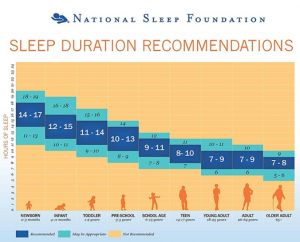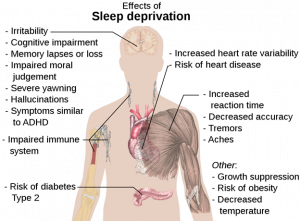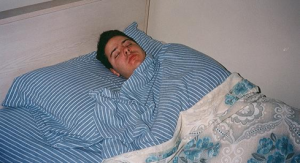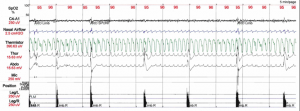7 Focused Assessment: Sleep Assessment
Learning Objectives
At the end of this chapter, the learner will:
- Assess sleep and rest patterns.
- Document the findings from sleep assessment.
I. Overview of Sleep
This chapter will introduce the assessment of sleep. Sleep is essential for human life as it provides healing and restoration to the body by lowering the metabolism, allowing countervailing restorative processes. The amount of sleep varies among individuals and across age groups. The National Sleep Foundation recommends specific sleep durations: newborn babies may need up to 18 hours of sleep, with this amount decreasing as the child ages. Toddlers typically require 11 to 14 hours of sleep, school-age children need 9 to 11 hours per night; teenagers will need 8 to 10 hours of sleep, and most healthy adults, aged 18 to 64 need about 7 to 9 hours of sleep every night. Individuals over 65 years old may need 7 to 8 hours of sleep (Hirshkowitz et al., 2015). See illustration below (Raparound, 2021).

Environmental distractors and stimulants such as caffeine and nicotine can affect the ability to fall asleep.
Periodic shift work may interrupt the circadian rhythm, change usual sleeping patterns, and result in sleep disruption. Medical and psychiatric conditions such as pain, shortness of breath, sleep apnea, and depression could also cause sleep disruptions. Inadequate sleep or sleep deprivation is related to impaired cognitive functions and is linked to poor memory, an increased risk for depression and obesity.
See illustration below (Häggström, 2014).

Knowledge Check
II. Stages of Sleep
Sleep is divided into 2 phases: non-rapid eye movement (NREM) and rapid eye movement (REM).
- NREM includes 3 stages:
Stage 1: Beginning to fall asleep. Heart rate and respiration rate decrease, and muscles relax. It is easy to be awoken in this stage.
Stage 2: Light sleep. Heart rate and respiration rate further decrease, and muscle relaxation deepens. Body temperature decreases, and eye movements stop.
Stage 3: Deep sleep. It is difficult to awake during this stage. Heart rate and respiration rate slow down to their lowest levels. If awoken in this stage, individuals may experience temporary mental impairment. During this stage, the immune system strengthens, and body tissues repair and regrow. (Patel et al., 2021).
- REM stage: During this stage, rapid eye movements occur under closed eyelids. Heart rate, respiration rate, and blood pressure increase to levels similar to waking state. Skeletal muscles are paralyzed, and high brain activity is observed. Most dreams occur during REM sleep. Proper REM sleep supports better mental concentration and mood regulation, enhancing work performance and quality of life (Dumper et al., n.d.).
NREM and REM sleep stages alternate in sleep cycles, which occur approximately every 90 minutes and repeat 4-6 times throughout sleep (Patel et al., 2021). Five full sleep cycles are equivalent to about 7.5 hours of sleep.
A more detailed overview of sleep stages is available at: https://opentext.wsu.edu/psych105/chapter/stages-of-sleep/
Knowledge Check
III. Medical Terminology
| circadian rhythm | natural cycle of physical, mental, and behavior changes that the body goes through in a 24-hour cycle |
| hypnotics | sleep-inducing drugs |
| insomnia | inability to sleep |
| narcolepsy | a neurological disorder characterized by overwhelming daytime drowsiness and sudden attacks of sleep |
| sedatives | drugs can calm down brain activity and may induce sleep |
| sleep apnea | a sleep disorder that occurs when breathing is interrupted during sleep |
| sleep deprivation | a condition caused by sleep deficiency which may affect cognitive and physical functions |
Knowledge Check
IV. Sleep Assessment
When assessing sleep, sleep history should be evaluated, including the total amount of sleep, usual sleep patterns, quality of sleep, and the use of sleeping aids such as alcohol, sedatives, or hypnotics.
Sample interview questions are like:
What is your usual sleep habit?
Are you able to fall asleep and stay asleep without difficulty?
How many hours of sleep do you have?
Are you getting adequate sleep?
Do you need to use any aid to induce sleep?
Health problems that interfere with sleep should also be assessed.
- Mental: anxiety? Stress?
- HEENT: nasal congestion? Pain?
- Neuro: headache/migraine? sleep apnea?
- Respiratory: shortness of breath? Cough?
- CV: chest pain? Palpitation? Leg pain?
- GI: pain in abdomen? Gastroesophageal reflux? Constipation or diarrhea?
- GU: frequent urination? Pain?
- MS and skin: pain in joints? Itching?
V. Documentation of Assessment Findings

VI. Related Diagnostic Tests
To evaluate sleep, a sleep diary or a sleep study are commonly used.
A sleep diary or sleep log is a subjective, self-reported way to record an individual’s sleeping and waking-related information. It is a useful tool for assessing sleep problems and can help individuals self-evaluate factors influencing their sleep (Mallinson et al., 2019).
A sleep study is a non-invasive test that records body activity during sleep. It can diagnose sleep disorders such as sleep apnea, narcolepsy, and insomnia, and is typically conducted in a sleep lab. During the study, the patient’s REM and NREM sleep cycles are observed using an EEG monitor. Other data such as eye movements, oxygen levels, heart rates, respiration rates, snoring, and body movements are also measured while the patient sleeps.
Polysomnography (PSG) is a type of sleep study that includes at least 3 independent tests (EEG, EOG, EMG) to monitor different body functions during sleep (Luyster et al., 2015):
∘ Electroencephalogram (EEG): Measures and records the brainwave activity to identify sleep stages and seizure activity.
∘ Electrooculogram (EOG): Records eye movements, which are important for identifying the various sleep stages, especially REM.
∘ Electromyogram (EMG): Records muscle activity such as teeth grinding and face twitches.
A sample of polysomnogram that records several physical variables is shown below.

VII. Learning Exercises
VIII. Attribution and References
- Dumper, K., Jenkins, W., Lacombe, A., Lovett, M., & Perimutter, M. (n.d.). Introductory Psychology. Introductory Psychology. https://opentext.wsu.edu/psych105/ Accessed June 28, 2021.
- Häggström, Mikael (2014). "Medical gallery of Mikael Häggström 2014". WikiJournal of Medicine 1 (2). DOI:10.15347/wjm/2014.008. ISSN 2002-4436. Public Domainhttps://commons.wikimedia.org/w/index.php?curid=6892366
- Hirshkowitz, M., Whiton, K., Albert, S. M., Alessi, C., Bruni, O., DonCarlos, L, Hazen, N. Herman, J., Katz, E.S., Kheirandish-Gozal, L., Neubauer, D., O’Donnell, A, Ohayan, M., Peever, J., Rawding, R., Sachdeva, R., Setters, B., Vitiello, M., Ware, C., and Hillard, A. (2015). National Sleep Foundation’s sleep time duration recommendations: methodology and results summary. Sleep Health. 1(1), 40–43. https://doi.org/10.1016/j.sleh.2014.12.010 Accessed June 25, 2021.
- Luyster, F. S., Choi, J., Yeh, C., Imes, C. C., Johansson, A. E., & Chasens, E. R. (2015). Screening and evaluation tools for sleep disorders in older adults. Applied Nursing Research, 28(4), 334-340. doi: 10.1016/j.apnr.2014.12.007
- Mallinson, D., Kamenetsky, M., Hagen, E., & Peppard, P. (2019). Subjective sleep measurement: comparing sleep diary to questionnaire. Nature and Science of Sleep, 11, 197-206. doi: 10.2147/NSS.S217867 Accessed June 28, 2021.
- National Sleep Foundation: Sleep by the numbers. 2021. https://www.thensf.org/sleep-facts-and-statistics/ Accessed June 24, 2021.
- Patel, A., Reddy, V., % Araujo, J. (2021). Physiology, sleep stages. StatPearls Publishing. https://www.ncbi.nlm.nih.gov/books/NBK526132/ Accessed June 30, 2021.
- Patient Safety Primer: Fatigue, Sleep Deprivation, and Patient Safety. 2019. https://psnet.ahrq.gov/primer/fatigue-sleep-deprivation-and-patient-safety#Current-Context Accessed June 24, 2021.
- Polylerus, Public domain via Wikimedia Commons https://upload.wikimedia.org/wikipedia/commons/6/69/Man_sleeping_striped-sheets.JPG
- Raparound, CC BY-SA 4.0 <https://creativecommons.org/licenses/by-sa/4.0>, via Wikimedia Commons, created Jan. 2021.
- Tonicthebrown, Public domain, via Wikimedia Commons https://upload.wikimedia.org/wikipedia/commons/5/5d/PLMD_Polysomnogram.png

